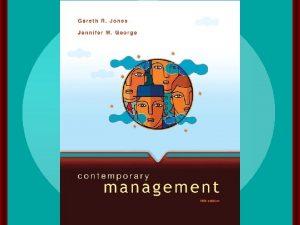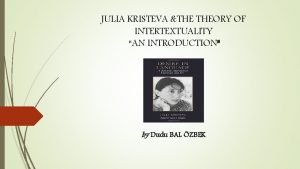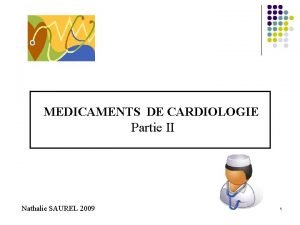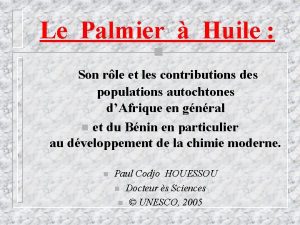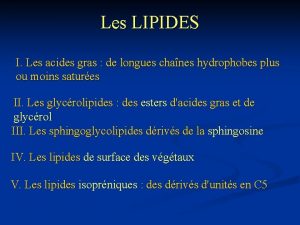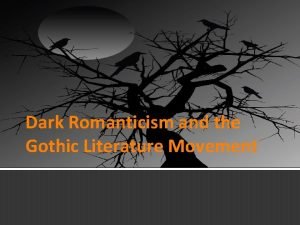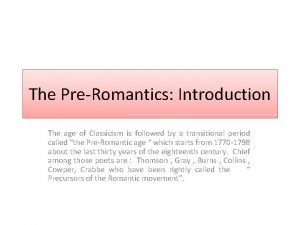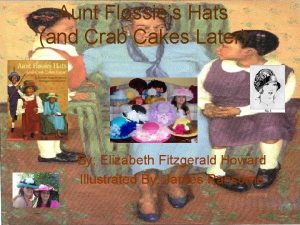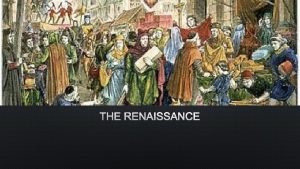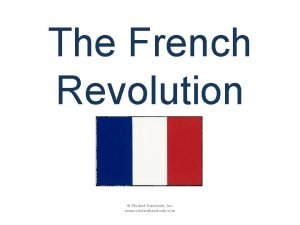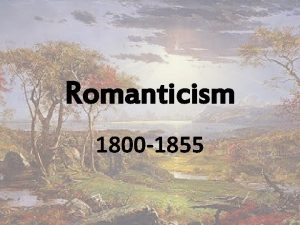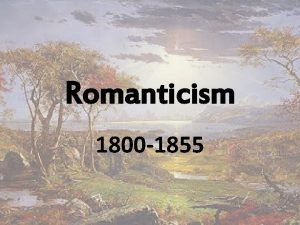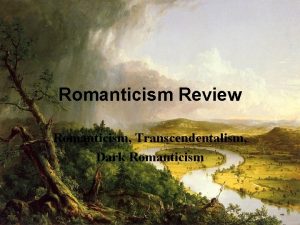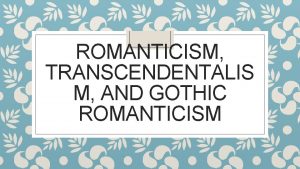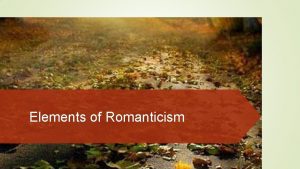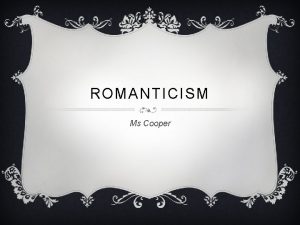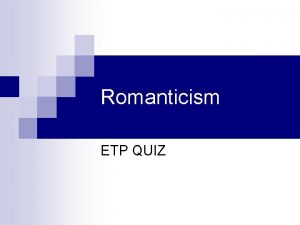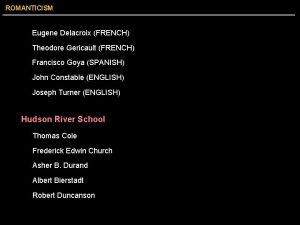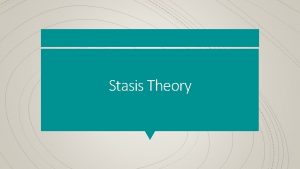ROMANTICISM The term Romanticism derives from the French












- Slides: 12

ROMANTICISM � The term Romanticism derives from the French word romance which referred to the vernacular languages derived from Latin and to the works written in those languages. � Also in England , in the Middle ages, there were cycles of “romances” dealing with the adventures of knights and containing supernatural elements. � Throughout the 18 th century “romantic” was used to describe the picturesque in the landscape. Gradually the term came to be applied to the feeling the landscape created in the observer, and generally to the evocation of subjective and incommunicable emotions.

THE AGE OF REVOLUTIONS THE ROMANTIC AGE The period from the declaration of American Independence (1776) to 1830 was marked by great revolutions: • The Industrial Revolution reshaped the social and political background of Britain in fact the British colonies on the other side of the Atlantic became a new and free nation; steam engines increased production, steam locomotion on the railways distributed the coal and iron, steam resulted in the change of location of industry. The Industrial Revolution resulted in the rise of a middle-class business interest. They wanted more political power in order to influence economic policy towards free trade and against the protection of old industries like agriculture. • The French Revolution spread its ideas of freedom and equality all over Europe. English liberals approved of the attack on the Catholic absolute monarchy. However, as a result of the Terror support of the French Revolution, many former radicals became conservative.

A NEW SENSIBILITY � At the end of the 18 th century a new sensibility became dominant which came to be known in literature as “Romanticism”and presented itself as a reaction against the faith in reason that had characterised the previous age, promoting instead the supremacy of feelings and emotions. � There was a great interest in humble and everyday life and in the country as a place where man’s relationship with nature was still intact , as opposed to the industrial town. � A new taste for the desolate , the love of ruins, such as ancient castles and abbeys came out to contrast the present reality. A new interest in the popular traditions of the Middle Ages was revealed in the so-called “Gothic Vogue”, that is the interest in what was wild, irrational, supernatural , horrific.

A NEW CONCEPT OF NATURE �Nature was no longer seen as a philosophical idea, something which man could rule by reason; slowly it came to be felt as a real living being to be described as it actually was. �Nature was considered as a living force, as the expression of God in the universe. It was the main source of inspiration, a stimulus to thought, a source of comfort and joy.

IMAGINATION AND CHILDHOOD �Imagination gained a key role as a means of giving expression to emotional experience not strictly accountable to reason. �The willingness to explore less conscious aspects of feeling was accompanied by a serious concern about the experience of childhood. �In a romantic mind a child was purerer than grownup people because he was unspoilt by civilisation. His uncorrupted sensitiveness brought him closer to God and the sources of creation, therefore childhood was admired and cultivated.

THE INDIVIDUAL � Great emphasis was placed on the significance of the individual. The Augustans had seen man as a social animal, in his relationship with his fellows. The Romantics saw the individual essentially in the solitary state; they exalted the atypical, the outcast, the rebel. � This attitude led , on the one hand, to the cult of the hero- the rebel in Coleridge, the Byronic hero, and on the other hand to the view of society as an evil force. � The current of thought represented by Jean-Jacques Rousseau (1712 -1778) encouraged the notion that the conventions of civilisation represented intolerable restrictions on the individual personality and produced every kind of corruption and evil. Consequently natural behaviour, unrestrained and impulsive, is good, in contrast to behaviour which is governed by reason, and by the rules and customs of society.

THE CULT OF THE EXOTIC � Rousseau’s theories also influenced the “cult of the exotic”, that which is far away both in space and in time. The remote and the unfamiliar in custom and social outlook was welcomed. � The remotest parts of Europe and the Far East had the appeal of being strange and unpredictable; danger and disaster, adventure and the inexplicable became symbols for other modes of human experience. � The “noble savage” concept is specifically a Romantic one: the savage may appear primitive, but actually he has an instinctive knowledge of himself and of the world often superior to that which has been acquired by civilised man.

THE ROMANTIC MOVEMENT � Romanticism in Europe developed in different ways and times according to the cultural, social and political situations of each country. � In Germany, anticipated by the Sturm und Drang movement of the 1770 s, the romantic ideas of Schlegel appeared on the pages of the review “Das Athenaum” in 1798; � In England, “The Lyrical Ballads” ( 1800)by William Wordsworth and S. T. Coleridge were published. These contained a Preface by Wordsworth which is considered the Manifesto of English Romantic Poetry. � “De l’Allemagne “ (1810) by Mme De Stael, spread the romantic principles in France , and the � “Lettera Semiseria” (1816) by Giovanni Berchet marked the official beginning of the Romantic movement in Italy.

IMAGINATION � English Romanticism saw the prevalence of poetry, which best suited the need to give expression to emotional experience and individual feelings. � Imagination gained a primary role in the process of poetic composition. The eye of the imagination allowed the Romantic poets to see beyond surface reality and apprehend a truth beyond the powers of reason. Imagination allowed the poet to re-create and modify the external world of experience. � The poet was seen as a “visionary prophet” or a “teacher” whose task was to mediate between man and nature, to point out the evils of society, to give voice to the ideals of beauty, truth and freedom.

POETIC TECHNIQUE �Breaking free from models and rules, the Romantic poets searched for a new, individual style through the choice of a language and subject suitable to poetry. �More vivid and familiar words began to replace the artificial circumlocutions of 18 th century diction; syntax made less concessions to the demands of rhyme and metre ; symbols and images lost their decorative function to assume a vital role as the outer, visible vehicles of the inner visionary perceptions. �As for verse form, there was a return to past forms such as the ballad, the Italian terza rima and ottava rima, the sonnet and blank verse

WILLIAM BLAKE �He was born in London in 1757. Trained as an engraver he practised this craft until his death. A political freethinker, he supported the French Revolution. He witnessed the evil effects of industrial development on man’s soul and for him the role of the artist was to be the guardian of the spirit and imagination. �The most important literary influence in his life was the Bible, because it presented a total vision of the world and its history. He is considered the forerunner of the Romantic Movement because he rejected neoclassical literary style and themes.

TWO GENERATIONS OF POETS � The great English Romantic Poets are usually grouped into two generations: � The first generation, often called “The Lake poets”, included W. Wordsworth and S. T. Coleridge. They were characterised by the attempt to theorise about poetry. Wordsworth would write on the beauty of nature and ordinary things with the aim of making them interesting for the reader; Coleridge instead, should deal with visionary topics, the supernatural, and mystery; � The second generation were George Gordon Byron, Percy Bysshe Shelley and John Keats. They all died very young and away from home, in Mediterranean countries. They experienced political disillusionment which is reflected , in their poetry, in the clash between the ideal and the real. Poetry was no longer regarded as an imitation of life, but coincided with the desire to challenge the cosmos, nature, political and social order. Individualism as well as the alienation of the artist from society, were stronger in this generation and found expression in the different attitudes of the three poets: the anticonformist, rebellious and cynical attitude of the Byronic Hero, ; the revolutionary spirit and stubborn hope of Shelley’s Prometheus and, finally, Keats’s escape into the world of classical beauty
 In a bureaucracy a manager's formal authority derives from
In a bureaucracy a manager's formal authority derives from Who coined the term intertextuality in the 1960‘s?
Who coined the term intertextuality in the 1960‘s? Nathalie saurel
Nathalie saurel Les dérives du pétrole sont des matériaux synthétiques
Les dérives du pétrole sont des matériaux synthétiques Produits dérivés du palmier à huile
Produits dérivés du palmier à huile Unité isoprénique
Unité isoprénique Dark romantic literature
Dark romantic literature Pre romantics
Pre romantics The romanticism (1795 — 1835) what is romanticism
The romanticism (1795 — 1835) what is romanticism Flossies kitten rescue
Flossies kitten rescue What does renaissance mean in french
What does renaissance mean in french Causes and effects of the french revolution
Causes and effects of the french revolution Paper mache pronunciation
Paper mache pronunciation
